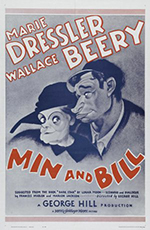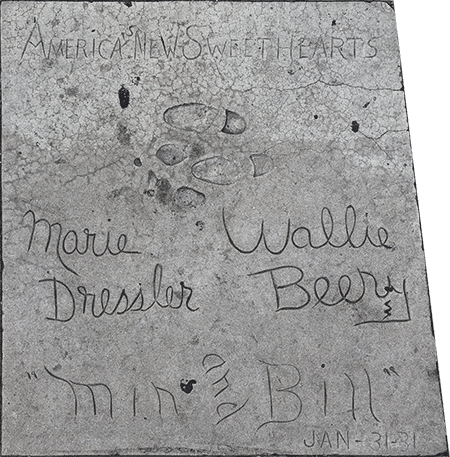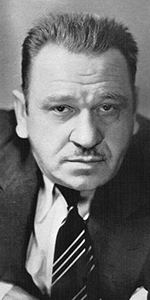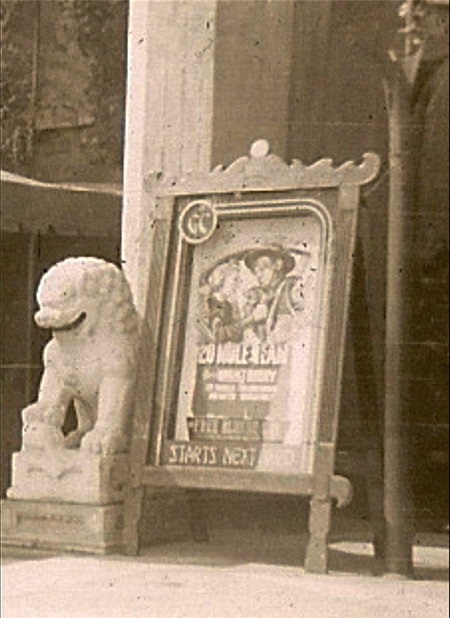|
 |
 |

|
 |
 |
 |
 |
| 1962 reissue one sheet poster for Min and Bill, originally released on November 29, 1930. |
| |
|
 |
|
|
|
| Min and Bill |
 |
| Footprinting Ceremony held on Saturday, January 31, 1931 |
| |
World Premiere, Friday, November 21, 1930, Capitol Theatre, in New York City
|
| |
Min and Bill was the little picture that could. Produced at Metro-Goldwyn-Mayer by Harry Rapf and director George W. Hill, the film was made for a song and became a runaway hit.
Based on a short story called Dark Star by Lorna Moon, Min and Bill told the story of Min, played by Marie Dressler, who runs a waterfront flophouse, as she frets over her adopted daughter who is now a young woman. Min has a relationship with a boozy fisherman, Bill, played by Wallace Beery. Dressler won the Best Actress Oscar for her performance in this film.
As was the custom, Min and Bill had its premiere in New York. The film was such a success, that it solidified Dressler's reputation as one of the sure-fire performers of the era, and did the same thing for Wallace Beery. Even though Min and Bill had not played the Chinese (it was too small a picture to be booked there really), in an unual twist, it was decided to commemorate the two performers in one block together honoring the one picture.
In 1933, Metro-Goldwyn-Mayer made a sequel of sorts, called Tugboat Annie, with Dressler and Beery playing different charcaters, but the setting and tonalities were essentially the same. The picture was directed by Mervyn LeRoy, and was an even bigger hit than Min and Bill. |
|
|
|
|
 |
 |
| Grauman's Chinese Theatre, Hollywood, California. Min and Bill Forecourt block. Executed by Jean Klossner, Saturday, January 31, 1931. 64 x 65 inches overall. |
 |
|
 |
|
 |
| Marie Dressler |
| |
Born: Lelia Marie Koerber, November 9, 1868, in Cobourg, Ontario, Canada
Age at the time of the ceremony: 62
Died: July 28, 1934, in Santa Barbara, California, age 65
|
| |
Marie Dressler was an experienced stage performer who had great success in silent films, but was especially popular in the early sound period.
Leaving home at age 14, Dressler soon learned the art of vaudeville stage comedy, becoming a gifted improvisor. Able to sing as well, Dressler appeared in light operas, taking the role of the battle-axe Katisha in The Mikado — the mind reels! Dressler made her Broadway debut in 1892. Maurice Barrymore, father of Lionel, Ethel and John, advised her to drop opera and to refine her comic skills.
In 1896, she had a great success with the Broadway play The Lady Slaver, which ran for two years. In 1900, she formed her own troupe, but their tour of Miss Prinnt folded, leaving Dressler broke, forcing her to sign a contract with Weber and Fields for a three-year deal. In 1907, she took a show called Philopoena to London's West End, where it flopped, so Dressler was broke once more.
After a few seasons of odd job performances, Dressler refined Tillie's Nightmare before it opened on Broadway, where it was a huge success in 1909. Dressler owned the rights to the play, and in 1914, she allowed Mack Sennett to adapt it as the first feature-length (78 minutes) movie comedy — Tillie's Punctured Romance (released in December 1914). Three more Tillie movies followed, making Dressler a movie star.
During World War I, Dressler toured the US, selling Liberty Bonds. She also entertained the American Expeditionary Forces in France.
After the war, Dressler attempted to get back into pictures, but found no takers. The short travel films she made in Europe didn't come off and were shelved. She announced her intention to retire. As a sign that she was hanging it up, she published her autobiography, The Story of an Ugly Duckling, in 1924.
Championed by screenwriter Frances Marion, to whom Dressler had shown much kindness to on the Tillie films, Dressler made The Callahans and the Murphys at M-G-M (released in June 1927). She returned to play Marion Davies' mother in The Patsy (released in March 1928). Dressler has a delightful number with Polly Moran and Bessie Love in The Hollywood Revue of 1929 (which World Premiered at the Chinese in June 1929).
During the run of that picture, Dressler appeared at the "Billion Dollar Midnite Matinee" late show on Saturday, July 6, 1929 in a star-studded micro version of Gus Edwards' musical School Days, along with Fanny Brice, Benny Rubin, George K. Arthur, Charles King, Bert Wheeler, Tom Patricola, Polly Moran, Lola Lane, Louise Groody and Louise Dresser.
Frances Marion used her pull to have Dressler cast in a supporting role in Anna Christie (released in February 1930), but it was Marion's script for Min and Bill which made her a household name, and for which she received an Oscar.
Several hits followed: Reducing (released in January 1931), and Politics, (released in July 1931) and Emma (released in January 1932). But in addition to Tugboat Annie (released in August 1933), the summer saw Dressler in her best-known role, that of Carllotta Vance in Dinner at Eight (which Premiered at the Chinese in August 1933). Her last film was Christopher Bean (released in November 1933).
Dressler died of cancer in 1934 at the age of 65. |
|
| |
|
 |
 |
 |
 |
| Wallace Beery in a portrait taken for his film Old Hutch, in 1936. |
| |
|
 |
|
|
|
| Wallace Beery |
| |
Born: April 1, 1885, in Clay County, Missouri
Age at the time of the ceremony: 45
Died: April 15, 1949, in Beverly Hills, California, age 64
|
| |
Wallace Beery had a very long and great career in films, from the silent era to the late 1940s. The man looked like a lug, but some of his performances are consummate displays of acting.
Not interested in school as a child, Beery "ran away to the circus" at age 16. He gave that up after being clawed by a leopard. In 1904, Beery joined his actor brother
Noah in New York, where Beery learned the technique of the stage in Summer Stock and Broadway. In 1913, Wallace Beery began his long career in movies by making His Athletic Wife (released in August 1913) for Essanay in Chicago. Beery learned the ropes by directing himself in a string of Sweedie comedy shorts for the studio.
While his marriage to Gloria Swanson didn't last, Beery's ability to play his roles skillfully did, despite his continual roistering. He rose to the top of the supporting-players list, usually playing the heavy: The Last of the Mohicans (released in November 1920), The Four Horsemen of the Apocalypse (released in March 1921), Douglas Fairbanks in Robin Hood (released in October 1922), The Sea Hawk (released in June 1924), So Big (released in December 1924), The Lost World (released in June 1925) and Old Ironsides (released in December 1926).
By the time Beery made his talkie debut in Beggars of Life (released in September 1928), he was the headliner. Finding star vehicles for him was easy, considering the inherent complexity of the man: both ham-fisted and brilliant. Min and Bill was only one of a string of hits for Beery: The Big House (released in June 1930), Billy the Kid (released in October 1930), The Champ (which had its World Premiere at the Chinese in November 1931, and for which Beery would recieve his Best Actor Oscar), his amazing performance in Grand Hotel (which also World Premiered at the Chinese in April 1932), Tugboat Annie (released in August 1933), Dinner at Eight (which Premiered at the Chinese in August 1933), Viva Villa! (released in April 1934), and Treasure Island (released in August 1934).
Beery remained a headliner at M-G-M for the rest of his life, so many of his films played at the Chinese: The Mighty Barnum in January 1935, West Point of the Air in April 1935, China Seas in August 1935, O'Shaughnessy's Boy in October 1935, Ah, Wilderness! in January 1936, A Message to Garcia in April 1936, Old Hutch in December 1936, Slave Ship in June 1937, The Bad Man of Brimstone in Janauary 1938, Port of Seven Seas in July 1938, Stablemates in October 1938, Stand Up and Fight in February 1939, Sergeant Madden in May 1939, Thunder Afloat in September 1939, The Man from Dakota in February 1940, 20 Mule Team in May 1940, Wyoming in October 1940, The Bad Man in March 1941, Barnacle Bill in July 1941, The Bugle Sounds in March 1942, Jackass Mail in August 1942, Salute to the Marines in September 1943, Rationing in March 1944, and Barbary Coast Gent in October 1944.
After the M-G-M films began showing at the Egyptian down the street, Beery's star power began to wane, with perhaps Beery's best role being A Date with Judy (released in July 1948). Beery continued to work until his fatal heart attack in 1949; he was 64. |
|
|
|
|
| |
 |
 |
| Grauman's Chinese Theatre, Hollywood, California. Marie Dressler and Wallace Beery footprinting ceremony, Saturday, January 31, 1931. Beery and Dressler have their imprints taken by Jean Klossner (in white on left). |
| |
 |
 |
| Grauman's Chinese Theatre, Hollywood, California. Forecourt poster case for the Wallace Beery starring picture 20 Mule Team, which will "starts next wed" meaning this photo was taken during the run of Johnny Apollo, beginning Wednesday, April 24, 1940. Photos like this are quite rare, but the Graumanschinese.org archive is deep — almost every film Beery made from 1935 to 1944 played the Chinese. |
|
|
|
 |
|
 |
|
|